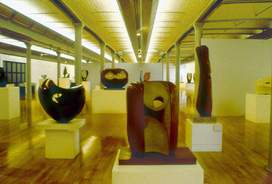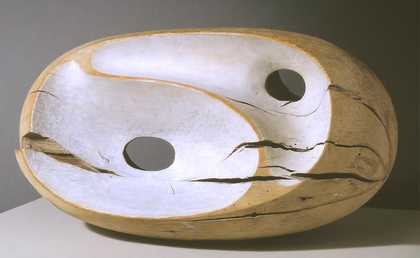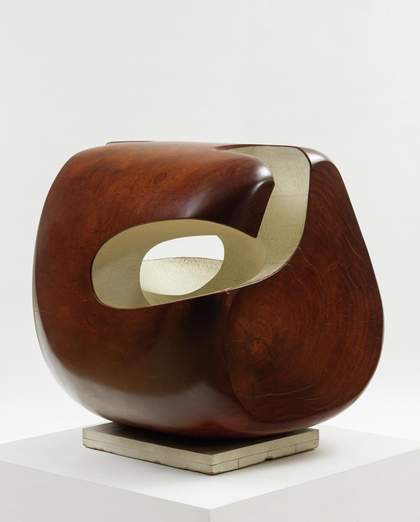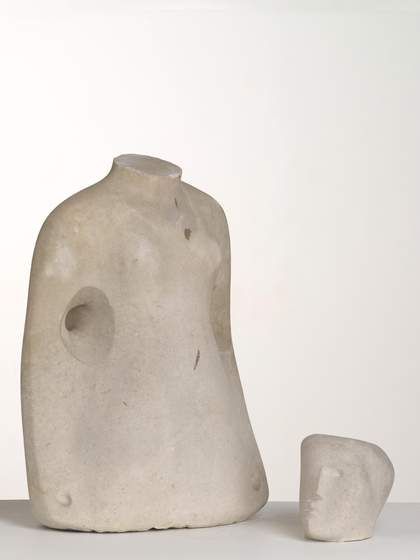
Hepworth Tate Liverpool Installation 1994
Barbara Hepworth was almost as old as this century: born in 1903, she died in 1975 aged 72. She came from a comfortable Yorkshire family in Wakefield, and both her parents and her art teacher at school supported her interest in art. She attended Leeds School of Art at the same time as Henry Moore, with whom her work has often been compared. Hepworth had set her sights on the Royal College of Art in London, and so spent only a year in Leeds, leaving for London at the same time as Moore.
Both Moore and Hepworth were to achieve notoriety for their carving, for to carve in the 1920s was to make a point of doing things differently. The conventional academic training for the would-be sculptor involved learning how to model in clay or plaster. If the work was then commissioned, the artist would have it cast in bronze or carved by a craftsman. The new creed was altogether different: the artist carried their own work through from beginning to end, in the material of their choice. In Hepworth's early carving you can quite clearly see her getting to know the limits of her material, revealing the original character of the block and the texture of the stone or wood.
In the mid-1920s a county scholarship enabled Hepworth to spend time in Italy.
'Italy opened for me the wonderful realm of light - light which transforms and reveals, which intensifies the subtleties of form and contours and colour ... To my Northern conception it added a knowledge of the grace of the Mediterranean approach which imparts a richness and gaiety into the 'living' material of marble and stone.'
By 1930, Hepworth's work was beginning to change. She looked less to the figure and was interested in more abstract forms of expression. This change coincided with the collapse of her marriage to her first husband, the sculptor John Skeaping with whom she had worked in the 1920s, and her new friendship with another artist, Ben Nicholson. Nicholson introduced her to artists in Paris such as Brancusi, Arp, Mondrian and Naum Gabo. Together Hepworth and Nicholson became involved in a new international crusade for abstract art.
Such was the novelty of abstract art at this time that artists and critics felt the need to define their beliefs and explain their position. Much of Hepworth's time was spent in discussing terms, writing statements, and promoting abstraction in publications and exhibitions. In her own work, she pushed abstraction to its limits, making purely geometrical shapes with no starting point in perceived reality.
Sculpture is made in several ways and from many different materials. Hepworth used a variety of materials and methods throughout her career. Carving directly into wood and stone gave her the most satisfaction as a sculptor, although it is often by her large-scale, outdoor work in bronze that she is best known. This exhibition concentrates on Hepworth's carvings, with a smaller selection of bronzes to mark her public work.
'I am basically and primarily a carver, and the properties of stone and wood and marble have obsessed me all my life.'
When war broke out, Hepworth and her children moved to St Ives in Cornwall. Life in Cornwall was very different from that in London, and during the war years a different Hepworth emerged. She developed a much more individual style which opens up the form, exploring the interiors of round or pointed oval shapes with strings and coloured paint. She worked with a much lighter touch, using wood in preference to stone.
'I used colour and string in many of the carvings of this time. The colour in the concavities plunged me into the depth of water, caves, or shadows deeper than the carved concavities themselves. The strings were the tension I felt between myself and these, the wind or the hills.'
After the war Hepworth remained in Cornwall, and her style changed again. She began to look to the figure and the relationships of groups of figures in space and in landscape.
With her renewed interest in the figure, Hepworth took up life drawing again. One of her most significant projects at this time was a series of drawings made in a hospital operating theatre. The opportunity arose during Hepworth's visits to the hospital where her daughter underwent several operations.
Although Hepworth was extremely active until the late 1960s, from the mid-1960s onwards she was increasingly affected by throat and mouth cancer. A bad fall affected her mobility, and her carving seemed to turn inwards, to become more private, more experimental. She made pieces which explore stacked vertical forms or arrangements of forms at the same level. These late works have a semi-rough quality which reveals both the quarryman's preparation and the mark of the artist's tools on the stone.
Fallen Images was Hepworth's last major sculpture. She died in a fire in her studio in 1975. Work like Fallen Images reminds us quite forcibly of the magic stones and menhirs of the hills and fields of Yorkshire and Cornwall. In pieces such as this Hepworth seems to return to the magic, to the arcane, to the mystery of stone.



